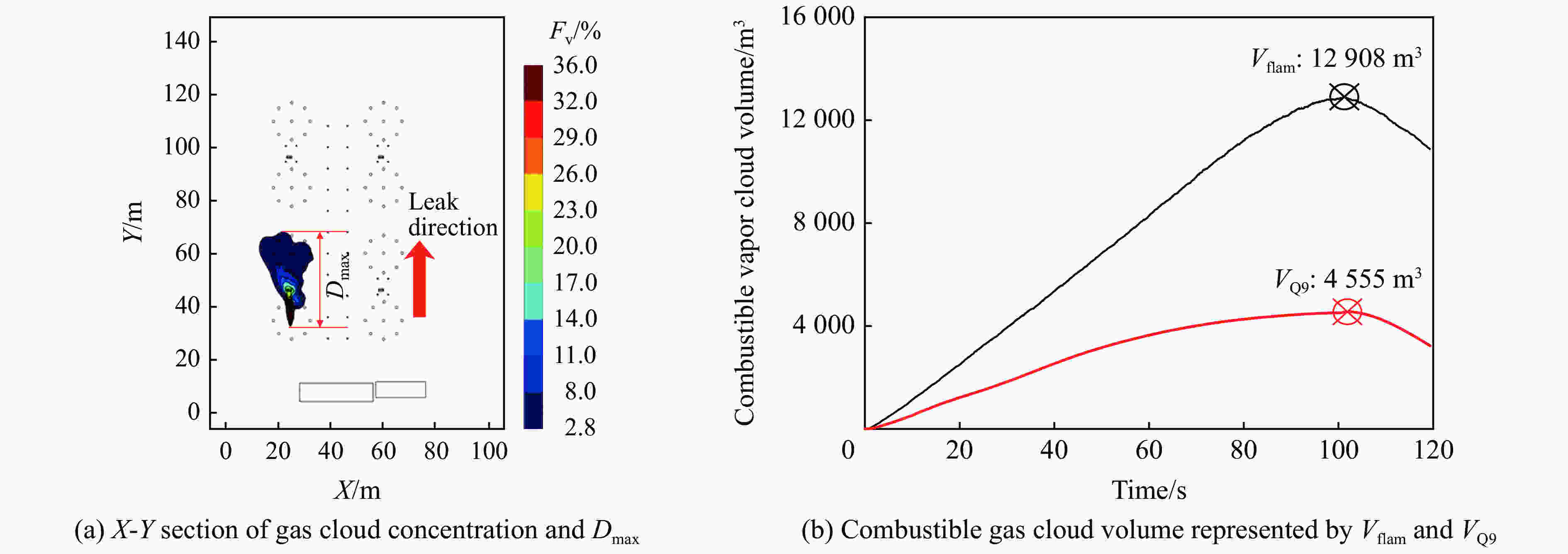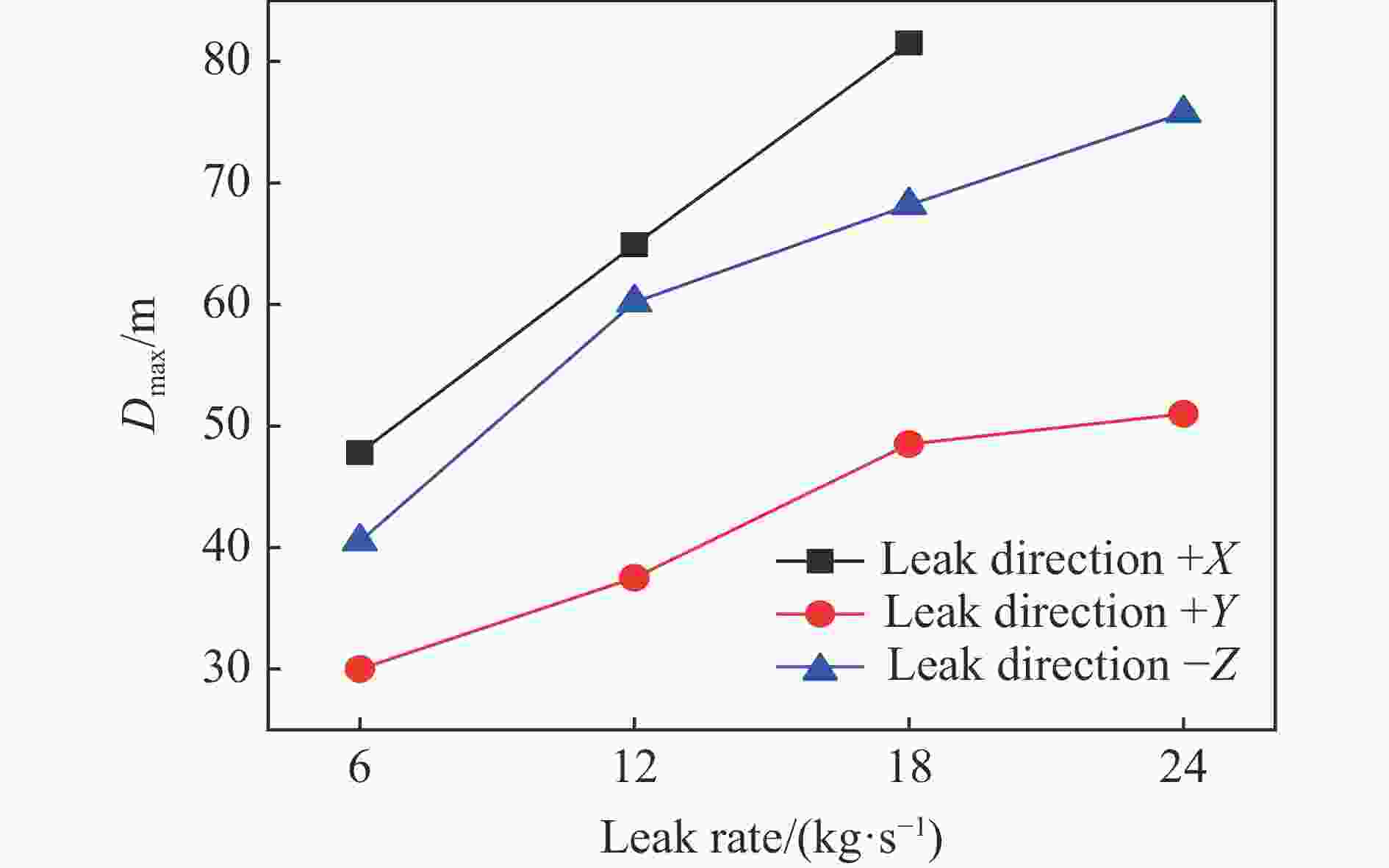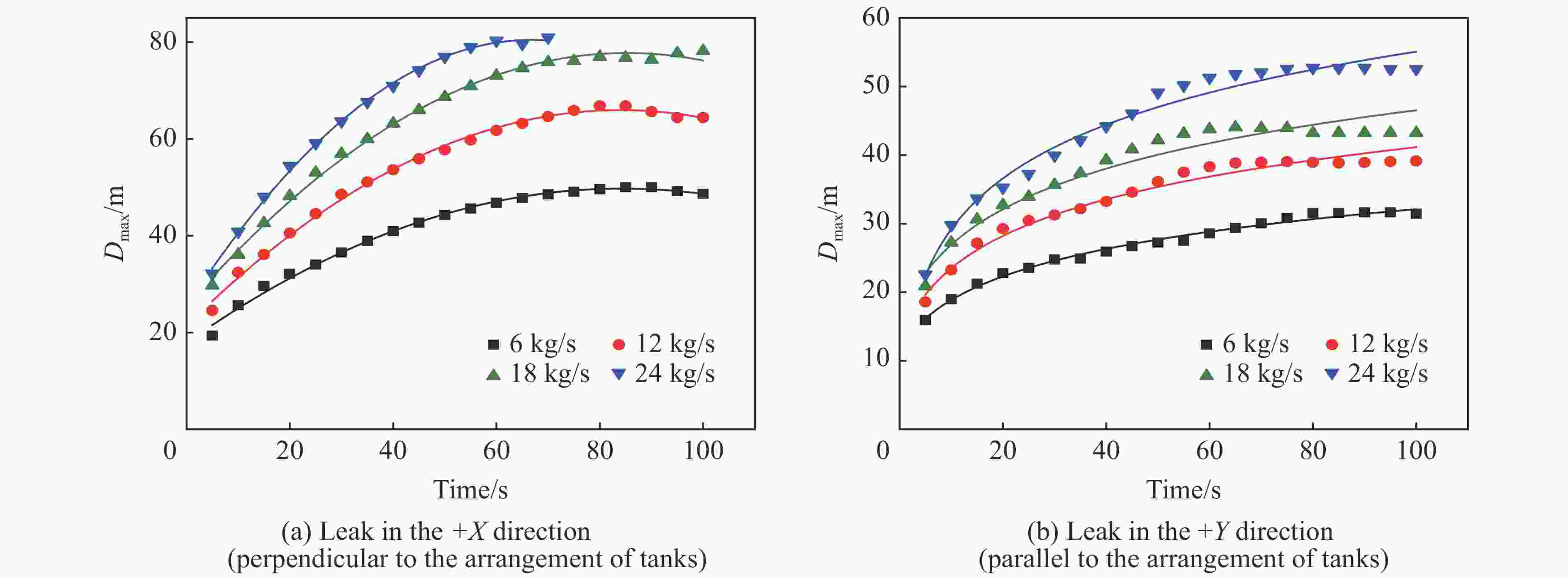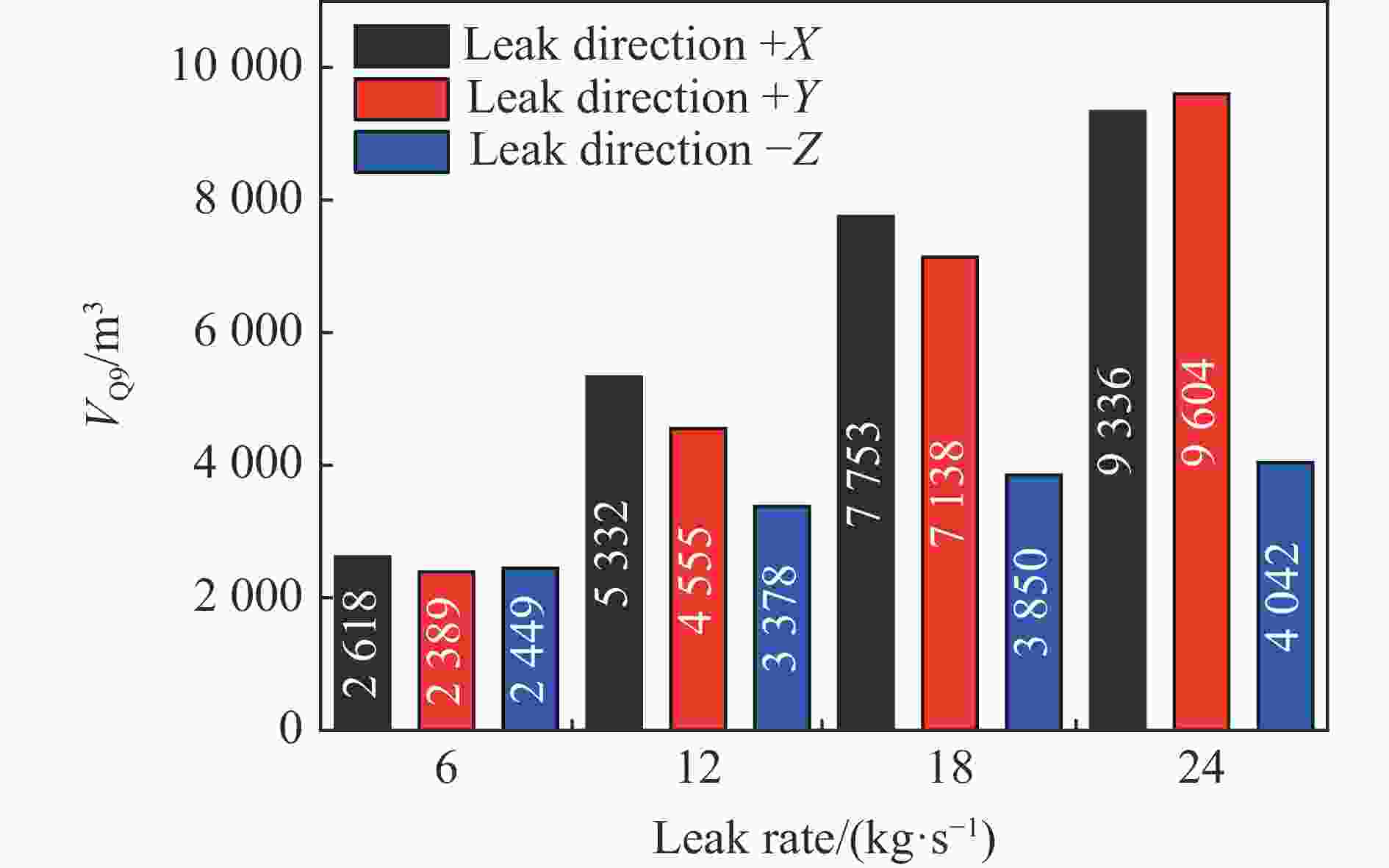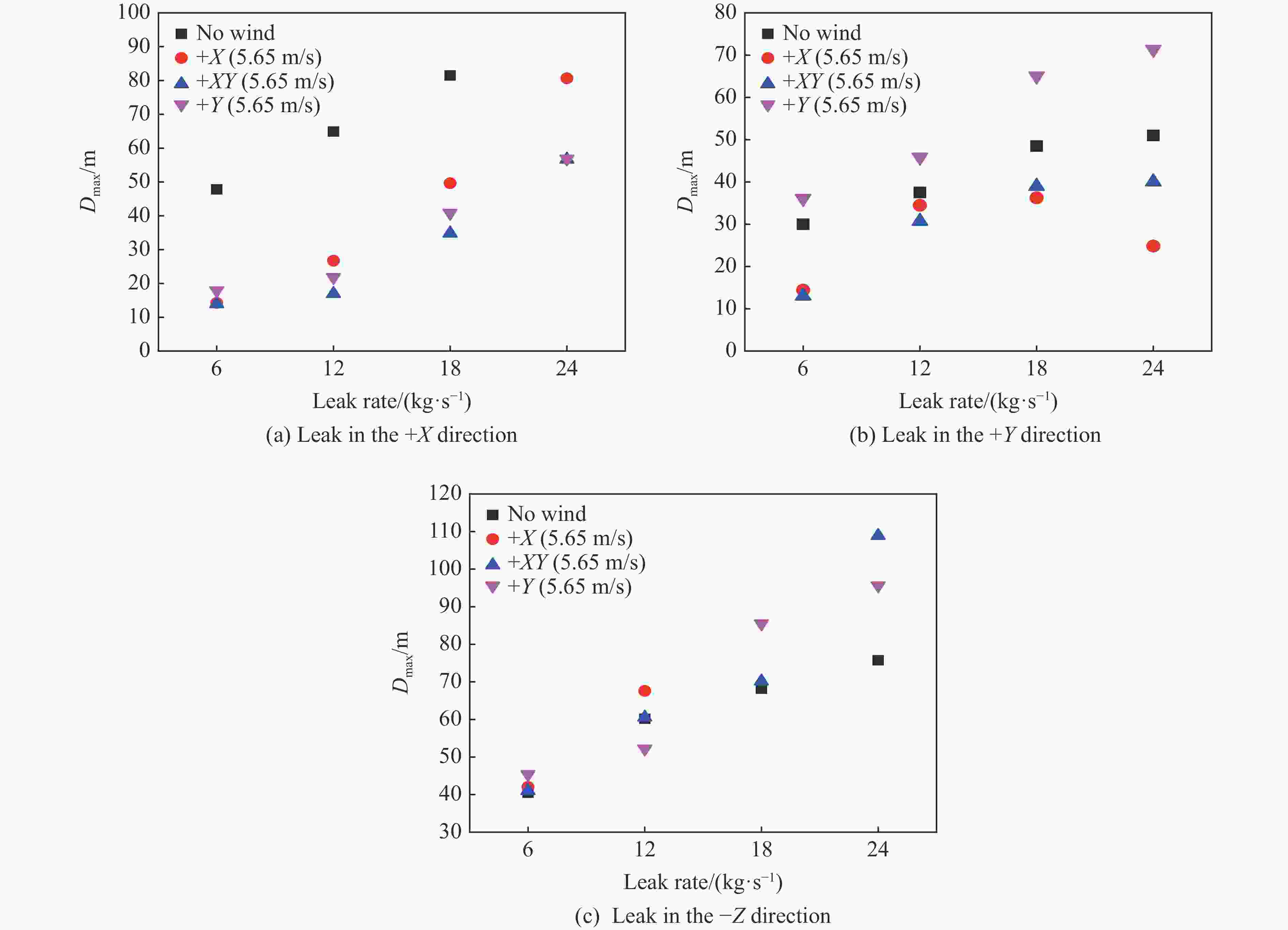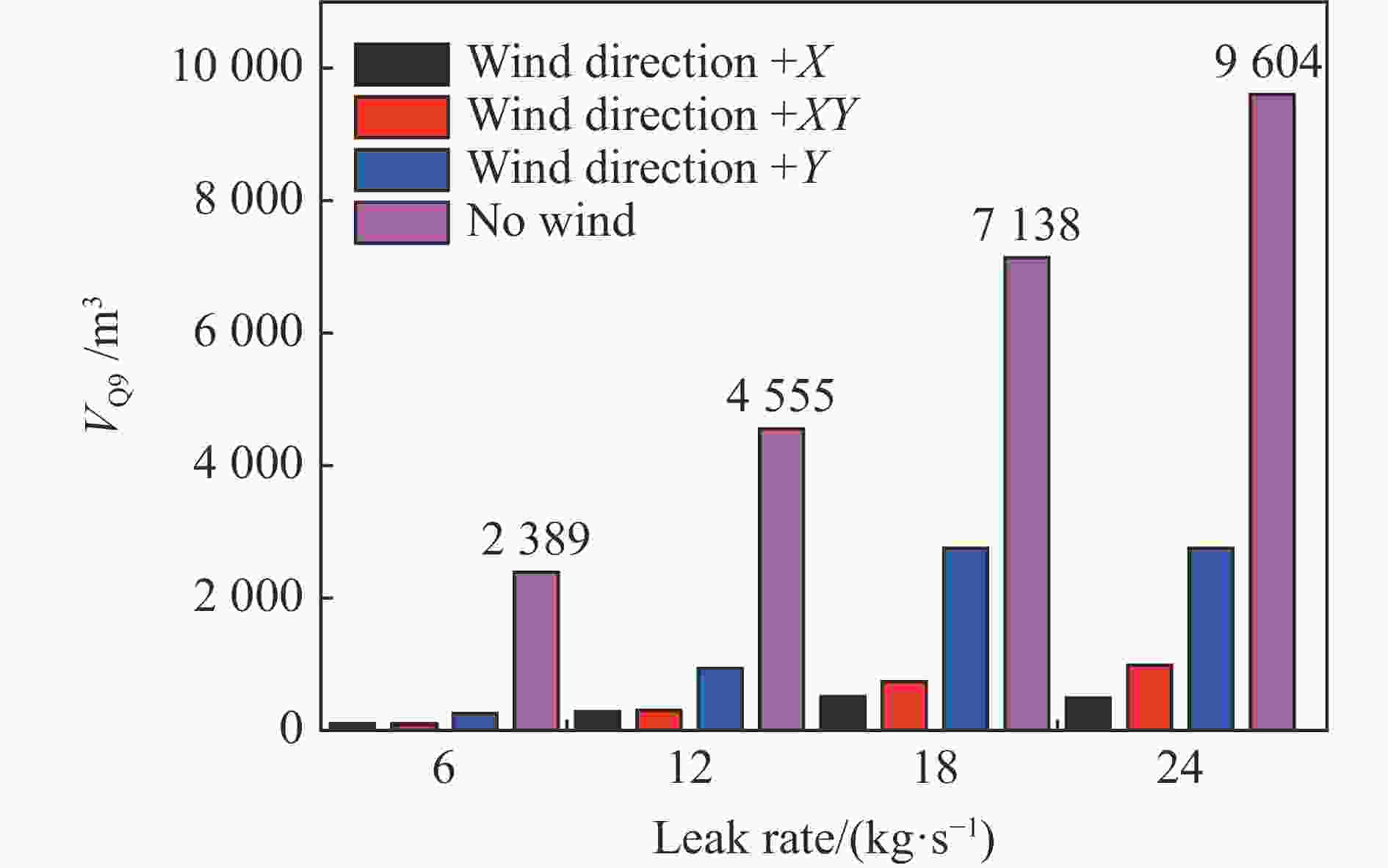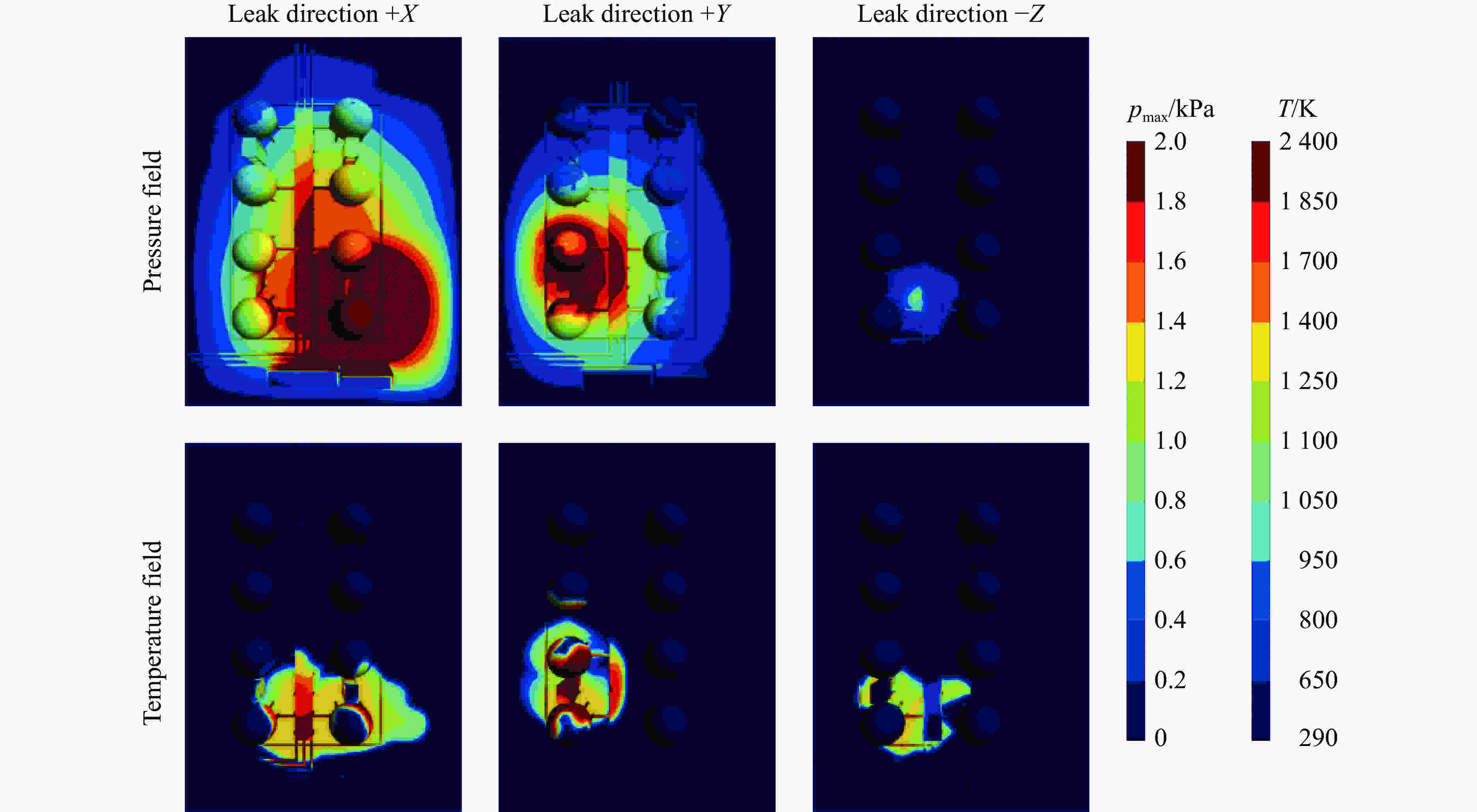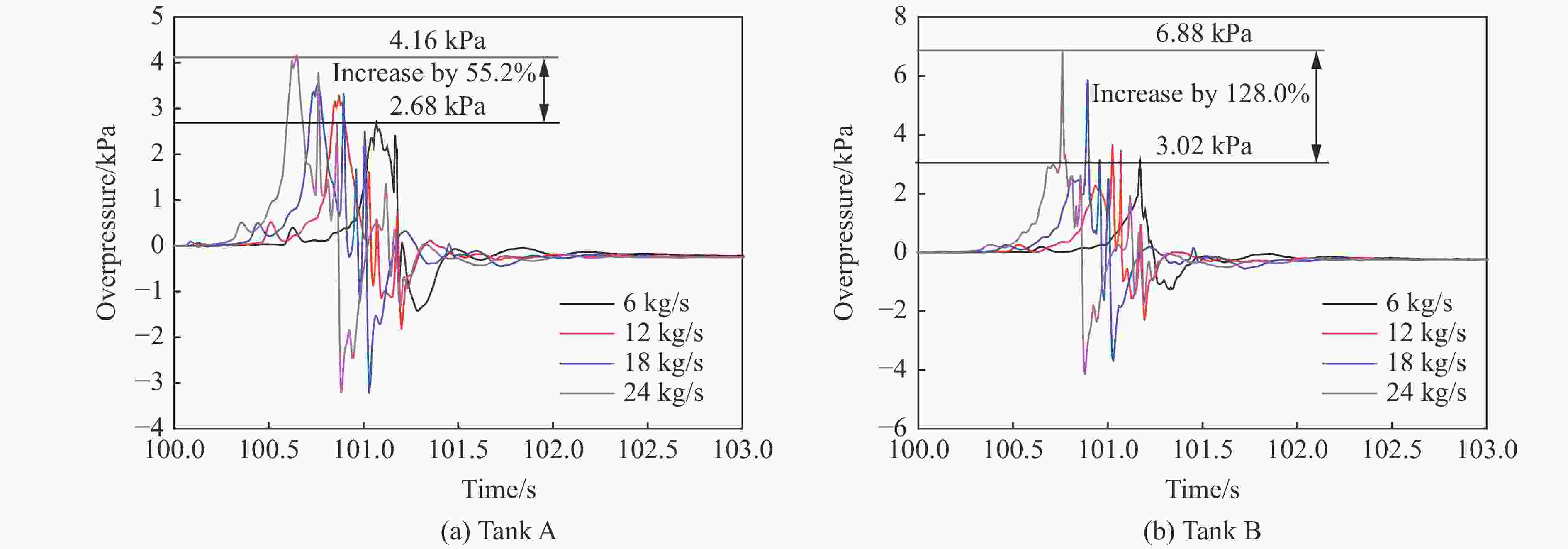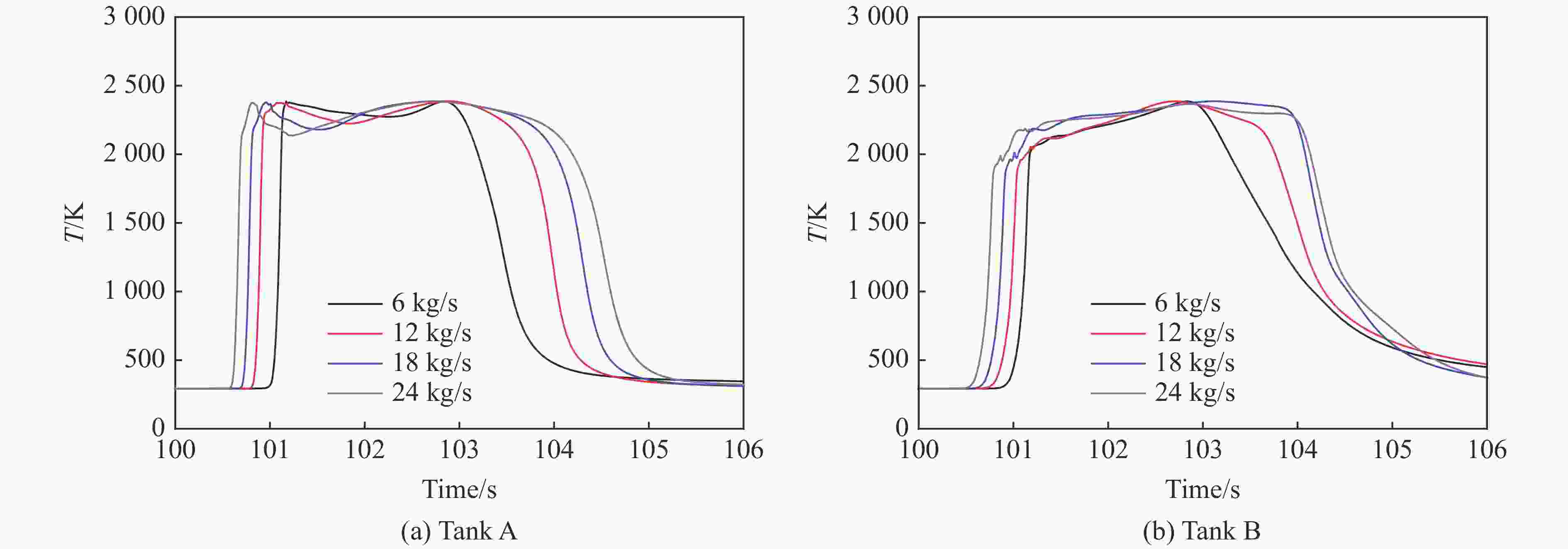Numerical simulation on gas dispersions and vapor cloud explosions induced by gas released from an ethylene storage tank
-
摘要: 储罐会因腐蚀或人为误操作等原因引发泄漏,造成泄漏气体扩散或气云爆炸事故。为了揭示此种事故的发展过程及影响规律,应用计算流体力学软件FLACS,研究了泄漏和环境风两个主要影响因素对乙烯气体扩散及爆炸的影响。结果表明:气云扩散距离和体积随泄漏速率增加而增大;当泄漏速率低于6 kg/s时,不同泄漏方向上的气云扩散距离及体积相近;当泄漏速率高于6 kg/s时,气体泄漏扩散和气云形成过程因受到障碍物影响,随阻塞率增大,气云扩散距离减小,气云体积增加。当泄漏方向垂直于储罐组中轴线,泄漏速率为18 kg/s时,气云扩散距离最大为81.5 m;当泄漏方向平行于储罐组中轴线,泄漏速率为24 kg/s时,气云体积最大达到9 604 m3。爆炸波的冲击压力随泄漏速率升高而升高;环境风会加快可燃气体稀释,有效降低气云爆炸发生的概率,降低爆炸强度,达到爆炸压力峰值的时间更早,可使高温在更短的时间内下降。泄漏速率为24 kg/s时,与泄漏储罐紧邻的储罐表面上被冲击到的爆炸超压仅为6.88 kPa,但温度高达2 384 K,因此,为避免事故发生时的二次灾害,救援中对储罐组的冷却降温尤为重要。Abstract: Storage tanks may leak due to corrosion or human error, resulting in released gas dispersion and vapor cloud explosion accidents. The computational fluid dynamics software FLACS was employed to reveal the development processes of explosion accidents and estimate their influences on the environment, focusing on the effect of the leakage and environmental wind as two dominant factors on the ethylene gas dispersion and gas explosion. The results show that gas cloud dispersion distance and gas cloud volume increase with the increasing leak rate. When the leak rate is less than 6 kg/s, the gas cloud dispersion distance and gas cloud volume are similar in different leak directions. When the leak rate is greater than 6 kg/s, the dispersion of released gas and formation of gas cloud are influenced by the obstacles. The gas cloud dispersion distance decreases and the gas cloud volume increases as the blockage rate of the geometric obstacles increases. When the leak direction is perpendicular to the central axis of the storage tank group and the leak rate is 18 kg/s, the gas cloud attains its maximum dispersion distance of 81.5 m. When the leak direction is parallel to the central axis of the storage tank group and the leak rate is 24 kg/s, the gas cloud reaches its maximum volume of 9 604 m3. The impact pressure of the explosion wave increases with the increase in the leak rate. Under the influence of the environmental wind, the dilution of combustible gas is prominently accelerated and the combustible gas cloud volume is substantially lessened. Meanwhile, the probability of ignition of gas clouds and the intensity of the vapor cloud explosion are effectively reduced. Moreover, the time corresponding to achieve the peak explosion pressure is earlier and the decrease of the temperature is quicker than their counterparts under the condition without the environmental wind. When the leak rate is 24 kg/s, the explosion overpressure around the leakage location on the surface of the tank is only 6.88 kPa, but the temperature is 2 384 K. Therefore, when the explosion accident occurs, cooling the storage tanks is crucial in rescue in order to avoid the secondary disaster.
-
Key words:
- FLACS /
- leakage and dispersion /
- gas cloud explosion /
- explosion pressure /
- explosion temperature
-
表 1 不同泄漏速率下Dmax和时间的拟合方程
Table 1. Fitting equations of Dmax and time under different leak rates
泄漏速率/(kg·s−1) +X 泄漏方向:y=c+ax+bx2 +Y 泄漏方向:y=b ln(x–a) c a b R2 a b R2 6 17.874 0.756 –0.004 0.994 –5.413 6.894 0.990 12 21.351 1.062 –0.006 0.996 –4.179 8.856 0.968 18 25.484 1.226 –0.007 0.996 –4.731 10.006 0.931 24 25.321 1.651 –0.012 0.998 –1.564 11.920 0.975 表 2 无风条件下的爆炸工况
Table 2. Explosion cases without wind
泄漏方向 泄漏速率/(kg·s−1) 点火位置 +X 6、12、18、24 点火源1 +Y 6、12、18、24 点火源2 −Z 6、12、18、24 点火源3 表 3 有风条件下的爆炸工况
Table 3. Explosion cases with wind
泄漏方向 泄漏速率/(kg·s−1) 环境风向 点火位置 +X 24 西风 (+X) 点火源1 +Y 6、12、18、24 南风 (+Y) 点火源2 −Z 18、24 西风 (+X) 点火源3 –Z 12、18、24 西南风 (+XY) 点火源3 表 4 不同条件下储罐表面的最大爆炸超压以及达到最大爆炸超压的时间
Table 4. The maximum explosion overpressure on the tank surface and the time required to reach it under different conditions
泄漏速率/(kg·s−1) 储罐A表面 储罐B表面 无风条件 有风条件 无风条件 有风条件 pmax/kPa tp/s pmax/kPa tp/s pmax/kPa tp/s pmax/kPa tp/s 6 2.68 101.067 2 0.03 99.997 8 3.02 101.170 7 0.02 99.997 8 12 3.28 100.870 6 1.46 100.617 6 3.66 101.024 8 1.14 100.603 3 18 3.55 100.758 6 2.46 100.555 8 5.86 100.894 6 2.98 100.584 3 24 4.16 100.647 1 4.03 100.539 1 6.88 100.761 4 3.50 100.545 4 表 5 不同条件下储罐表面的最高温度以及达到最高所需的时间
Table 5. The maximum temperature on the tank surface and the time required to reach it under different conditions
泄漏速率/(kg·s−1) 储罐A表面 储罐B表面 无风条件 有风条件 无风条件 有风条件 Tmax/K tt/s Tmax/K tt/s Tmax/K tt/s Tmax/K tt/s 6 2 384 102.838 5 2 050 102.075 5 2 385 102.831 4 1 002 103.030 2 12 2 386 102.884 6 2 374 101.530 9 2 386 102.706 2 2 096 100.781 8 18 2 386 102.736 1 2 375 101.012 5 2 386 103.119 7 2 364 100.834 3 24 2 384 102.730 6 2 384 102.101 7 2 366 102.861 5 2 336 101.258 3 表 6 爆炸超压对建筑物的破坏作用
Table 6. Destructive effect of explosion overpressure on building surface
建筑类型 爆炸超压/kPa 完全毁坏 严重毁坏 中等毁坏 轻度毁坏 轻微毁坏 钢筋混凝土建筑 80~100 50~80 30~50 10~30 3~10 多层砖结构 20~40 20~30 10~20 5~10 3~5 少层砖结构 35~45 25~35 15~25 5~15 3~5 木建筑物 20~30 12~20 8~12 5~8 3~5 工业钢架建筑物 50~80 30~50 20~30 5~20 3~5 -
[1] CHANG J I, LIN C C. A study of storage tank accidents [J]. Journal of Loss Prevention in the Process Industries, 2006, 19(1): 51–59. DOI: 10.1016/j.jlp.2005.05.015. [2] LIAW H J. Lessons in process safety management learned in the Kaohsiung gas explosion accident in Taiwan [J]. Process Safety Progress, 2016, 35(3): 228–232. DOI: 10.1002/prs.11818. [3] 朱红亚, 陈昊东, 王青松, 等. 多源重气泄漏扩散模拟研究 [J]. 中国科学技术大学学报, 2014, 44(8): 697–703. DOI: 10.3969/j.issn.0253-2778.2014.08.010.ZHU H Y, CHEN H D, WANG Q S, et al. Simulation research on leakage and dispersion of multi-source heavy gas [J]. Journal of University of Science and Technology of China, 2014, 44(8): 697–703. DOI: 10.3969/j.issn.0253-2778.2014.08.010. [4] 李萍, 丁珏, 翁培奋. 两种颗粒湍流扩散模型数值模拟气液两相流泄漏扩散的比较 [J]. 爆炸与冲击, 2005, 25(6): 541–546. DOI: 10.11883/1001-1455(2005)06-0541-06.LI P, DING J, WENG P F. A numerical simulation on liquid gas two phase leakage dispersion by using two particle turbulent models [J]. Explosion and Shock Waves, 2005, 25(6): 541–546. DOI: 10.11883/1001-1455(2005)06-0541-06. [5] 邓小娇, 姚安林, 徐涛龙, 等. 城市综合管廊燃气舱室输气管道泄漏扩散规律研究 [J]. 中国安全生产科学技术, 2019, 15(11): 83–89. DOI: 10.11731/j.issn.1673-193x.2019.11.013.DENG X J, YAO A L, XU T L, et al. Study on leakage and diffusion laws of gas pipeline in gas cabin of urban utility tunnel [J]. Journal of Safety Science and Technology, 2019, 15(11): 83–89. DOI: 10.11731/j.issn.1673-193x.2019.11.013. [6] LI X H, CHEN G M, ZHANG R R, et al. Simulation and assessment of underwater gas release and dispersion from subsea gas pipelines leak [J]. Process Safety and Environmental Protection, 2018, 119: 46–57. DOI: 10.1016/j.psep.2018.07.015. [7] 任少云. 开敞空间液化天然气泄漏低温扩散及爆炸传播规律 [J]. 爆炸与冲击, 2018, 38(4): 891–897. DOI: 10.11883/bzycj-2016-0323.REN S Y. The leakage, low temperature diffusion and explosion of liquefied natural gas in open space [J]. Explosion and Shock Waves, 2018, 38(4): 891–897. DOI: 10.11883/bzycj-2016-0323. [8] LOVREGLIO R, RONCHI E, MARAGKOS G, et al. A dynamic approach for the impact of a toxic gas dispersion hazard considering human behaviour and dispersion modelling [J]. Journal of Hazardous Materials, 2016, 318: 758–771. DOI: 10.1016/j.jhazmat.2016.06.015. [9] 黄有波, 董炳燕, 吕淑然, 等. 天然气管道泄漏孔形状对喷射火影响模拟研究 [J]. 中国安全科学学报, 2015, 25(7): 62–67. DOI: 10.16265/j.cnki.issn1003-3033.2015.07.010.HUANG Y B, DONG B Y, LYU S R, et al. Simulation study on influence of natural gas pipeline leak hole shape on jet fire [J]. China Safety Science Journal, 2015, 25(7): 62–67. DOI: 10.16265/j.cnki.issn1003-3033.2015.07.010. [10] GEXCON A S. FLACS V10.9 user’s manual [M]. Norway: Gexcon, 2019. [11] MIDDHA P, ICHARD M, ARNTZEN B J. Validation of CFD modelling of LH2 spread and evaporation against large-scale spill experiments [J]. International Journal of Hydrogen Energy, 2011, 36(3): 2620–2627. DOI: 10.1016/j.ijhydene.2010.03.122. [12] MIDDHA P, HANSEN O R. Using computational fluid dynamics as a tool for hydrogen safety studies [J]. Journal of Loss Prevention in the Process Industries, 2009, 22(3): 295–302. DOI: 10.1016/j.jlp.2008.10.006. [13] MIDDHA P, HANSEN O R, STORVIK I E. Validation of CFD-model for hydrogen dispersion [J]. Journal of Loss Prevention in the Process Industries, 2009, 22(6): 1034–1038. DOI: 10.1016/j.jlp.2009.07.020. [14] HANSEN O R, GAVELLI F, ICHARD M, et al. Validation of FLACS against experimental data sets from the model evaluation database for LNG vapor dispersion [J]. Journal of Loss Prevention in the Process Industries, 2010, 23(6): 857–877. DOI: 10.1016/j.jlp.2010.08.005. [15] SCHLEDER A M, MARTINS M R. Experimental data and CFD performance for CO2 cloud dispersion analysis [J]. Journal of Loss Prevention in the Process Industries, 2016, 43: 688–699. DOI: 10.1016/j.jlp.2016.03.027. [16] FIATES J, SANTOS R R C, NETO F F, et al. An alternative CFD tool for gas dispersion modelling of heavy gas [J]. Journal of Loss Prevention in the Process Industries, 2016, 44: 583–593. DOI: 10.1016/j.jlp.2016.08.002. [17] WANG Q, SUN Y, LI X, et al. Process of natural gas explosion in linked vessels with three structures obtained using numerical simulation [J]. Processes, 2020, 8(1): 52. DOI: 10.3390/pr8010052. [18] 文虎, 高慧慧, 王秋红, 等. 泄爆口强度对管内天然气爆炸流场的影响仿真 [J]. 天然气工业, 2019, 39(8): 126–136. DOI: 10.3787/j.issn.1000-0976.2019.08.016.WEN H, GAO H H, WANG Q H, et al. A simulation study on the influence of vent port strength on the natural gas explosion flow field in line pipes [J]. Natural Gas Industry, 2019, 39(8): 126–136. DOI: 10.3787/j.issn.1000-0976.2019.08.016. [19] LI J D, MA G W, ABDEL-JAWAD M, et al. Gas dispersion risk analysis of safety gap effect on the innovating FLNG vessel with a cylindrical platform [J]. Journal of Loss Prevention in the Process Industries, 2016, 40: 304–316. DOI: 10.1016/j.jlp.2016.01.005. [20] LI J, MA G, HAO H, et al. Gas explosion analysis of safety gap effect on the innovating FLNG vessel with a cylindrical platform [J]. Journal of Loss Prevention in the Process Industries, 2016, 44: 263–274. DOI: 10.1016/j.jlp.2016.09.019. [21] LI J, MA G, HAO H, et al. Optimal blast wall layout design to mitigate gas dispersion and explosion on a cylindrical FLNG platform [J]. Journal of Loss Prevention in the Process Industries, 2017, 49: 481–492. DOI: 10.1016/j.jlp.2017.05.025. [22] HUANG Y, MA G, LI J. Multi-level explosion risk analysis (MLERA) for accidental gas explosion events in super-large FLNG facilities [J]. Journal of Loss Prevention in the Process Industries, 2017, 45: 242–254. DOI: 10.1016/j.jlp.2016.11.004. [23] 王志寰, 李成兵, 周宁. 大型LNG接收站泄漏事故灾害效应分析与预测 [J]. 天然气工业, 2019, 39(5): 145–153. DOI: 10.3787/j.issn.1000-0976.2019.05.018.WANG Z H, LI C B, ZHOU N. Analysis and prediction on the disaster effect of leakage accidents at large LNG receiving stations [J]. Natural Gas Industry, 2019, 39(5): 145–153. DOI: 10.3787/j.issn.1000-0976.2019.05.018. [24] BJEKETVEDT D, BAKKE J R, Van WINGERDEN K. Gas explosion handbook [J]. Journal of Hazardous Materials, 1997, 52(1): 1–150. DOI: 10.1016/S0304-3894(97)81620-2. [25] 杨国刚, 丁信伟, 毕明树, 等. 燃料浓度对可燃气云爆炸影响的实验研究与数值模拟 [J]. 石油学报(石油加工), 2004, 20(5): 53–58. DOI: 10.3969/j.issn.1001-8719.2004.05.010.YANG G G, DING X W, BI M S, et al. Experimental and simulation study of the effect of fuel concentration on flammable vapor cloud explosion [J]. Acta Petrolei Sinica (Petroleum Processing Section), 2004, 20(5): 53–58. DOI: 10.3969/j.issn.1001-8719.2004.05.010. [26] ZHANG S H, ZHANG Q. Influence of geometrical shapes on unconfined vapor cloud explosion [J]. Journal of Loss Prevention in the Process Industries, 2018, 52: 29–39. DOI: 10.1016/j.jlp.2018.01.004. [27] HANSEN O R, GAVELLI F, DAVIS S G, et al. Equivalent cloud methods used for explosion risk and consequence studies [J]. Journal of Loss Prevention in the Process Industries, 2013, 26(3): 511–527. DOI: 10.1016/j.jlp.2012.07.006. [28] 李炜, 槐文信. 浮力射流的理论及应用[M]. 北京: 科学出版社, 1997. [29] ATKINSON G, COWPE E, HALLIDAY J, et al. A review of very large vapour cloud explosions: cloud formation and explosion severity [J]. Journal of Loss Prevention in the Process Industries, 2017, 48: 367–375. DOI: 10.1016/j.jlp.2017.03.021. [30] LV D, TAN W, LIU L Y, et al. Research on maximum explosion overpressure in LNG storage tank areas [J]. Journal of Loss Prevention in the Process Industries, 2017, 49: 162–170. DOI: 10.1016/j.jlp.2017.06.010. [31] MA G W, LI J D, ABDEL-JAWAD M. Accuracy improvement in evaluation of gas explosion overpressures in congestions with safety gaps [J]. Journal of Loss Prevention in the Process Industries, 2014, 32: 358–366. DOI: 10.1016/j.jlp.2014.10.007. -






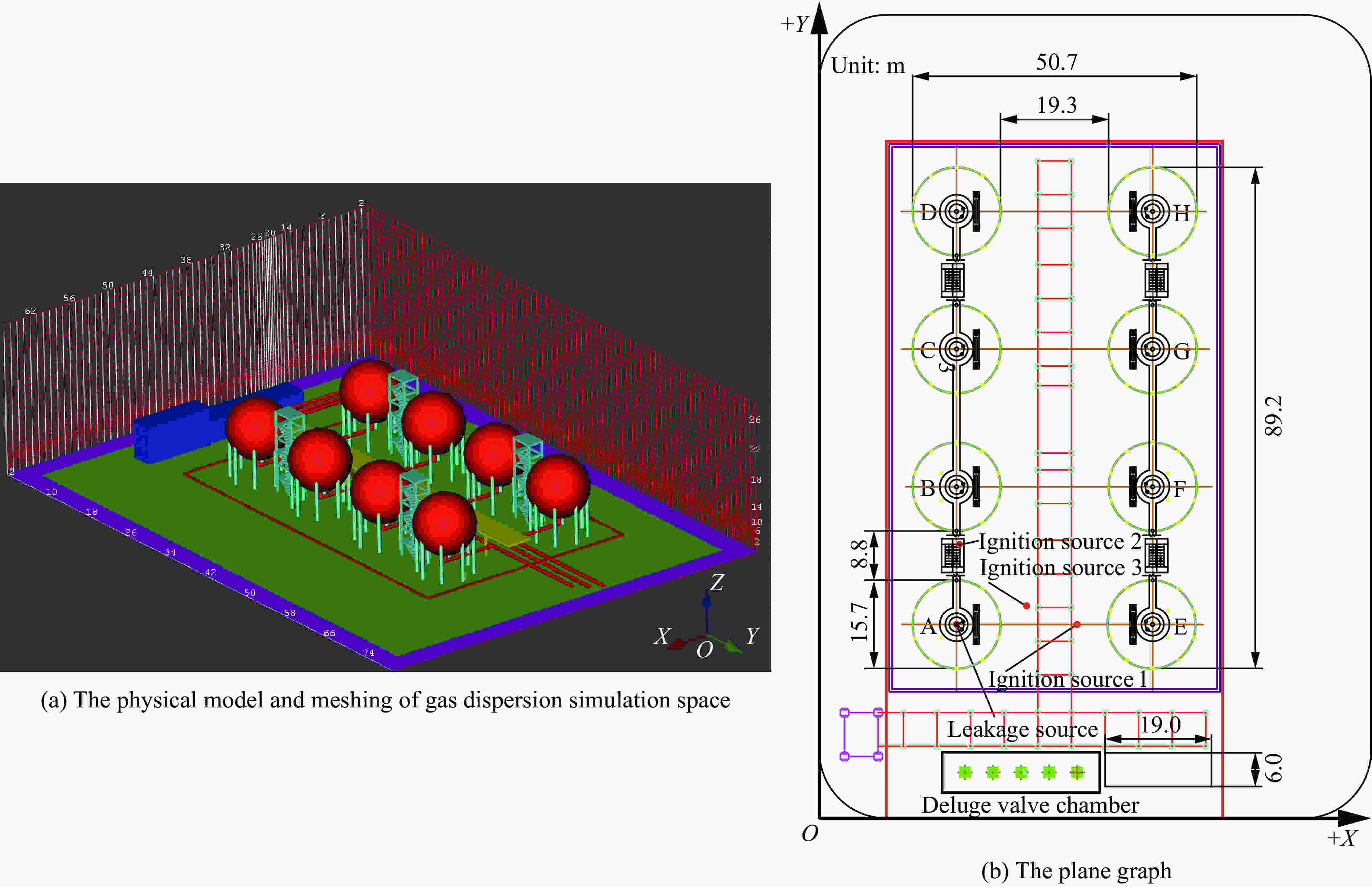
 下载:
下载:
